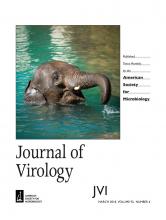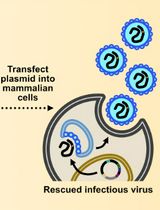- EN - English
- CN - 中文
Retroviral Capsid Core Stability Assay
逆转录病毒核衣壳稳定性检测
发布: 2018年09月20日第8卷第18期 DOI: 10.21769/BioProtoc.3019 浏览次数: 6075
评审: Vamseedhar RayaproluRavi KantSzu-Ting Chen

相关实验方案

诱导型HIV-1库削减检测(HIVRRA):用于评估外周血单个核细胞中HIV-1潜伏库清除策略毒性与效力的快速敏感方法
Jade Jansen [...] Neeltje A. Kootstra
2025年07月20日 1981 阅读
Abstract
Structural stability of the capsid core is a critical parameter for the productive infection of a cell by a retrovirus. Compromised stability can lead to premature core disassembly, exposure of replication intermediates to cytosolic nucleic acid sensors that can trigger innate antiviral responses, and failure to integrate the proviral genome into the host DNA. Thus, core stability is a critical feature of viral replicative fitness. While there are several well-described techniques to assess viral capsid core stability, most are generally time and labor intensive. Recently, our group compared the relative stability of murine leukemia virus capsid cores using an in vitro detergent-based approach combined with ultracentrifugation against the popular fate of capsid assay. We found that both methods reached similar conclusions, albeit the first method was a significantly simpler and faster way to assess relative capsid core stability when comparing viral mutants exhibiting differences in core stability.
Keywords: Retrovirus (逆转录病毒)Background
Retroviruses have evolved replication cycles that excel in circumventing host antiviral responses. One strategy that retroviruses have developed is to shield their replication intermediates from cytosolic nucleic acid sensors such as cGAS, TREX1, IFI203, and DDX41 (Yan et al., 2010; Gao et al., 2013; Lahaye et al., 2013; Stavrou et al., 2015). During replication, retroviruses produce RNA-DNA hybrids and unmethylated double-stranded proviral DNA in the cytosol that are common targets for innate immune sensors (Yan et al., 2010; Gao et al., 2013; Lahaye et al., 2013). The mature retroviral capsid core is constituted by about 1,500 units of the viral capsid protein (CA) that assemble to form a rigid structure that houses two copies of the retroviral RNA genome, the viral reverse-transcriptase, various other host-derived molecules (e.g., miRNAs, proteins, dNTPs), and in some cases, viral accessory proteins (Ganser et al., 1999; Briggs et al., 2004; Cantin et al., 2005; Campbell and Hope, 2015). This structure is permissive to the diffusion of dNTPs, yet it is impermeable to most host proteins (Jacques et al., 2016). In order to successfully and efficiently deliver the proviral DNA associated with the pre-integration complex (PIC) to the nucleus of the cell, the viral core must maintain a certain level of stability. Once it is physically situated proximal to a nuclear pore complex, the PIC may traverse into the nucleus and deliver the proviral DNA. Capsid cores that lack structural integrity or are destabilized by host restriction factors, like TRIM5α, will trigger innate responses and fail to deliver proviral DNA to the nucleus (Sayah et al., 2004; Stremlau et al., 2004 and 2006).
One of the most commonly used methods of analyzing retrovirus capsid core stability is known as the ‘fate of capsid assay’ (Stremlau et al., 2006; Perron et al., 2007; Yang et al., 2014). This assay involves infecting cells and then detecting the amount of intact pelletable capsid cores in the lysates of the infected cells. While this assay can compare relative levels of cores that persist in the cytosol over time, it is quite labor intensive, time-consuming and requires very large quantities of virus. In our hands, the ‘fate of capsid assay’ required the equivalent of 108 Transducing Units (TU–as measured by productive infections) of Moloney Murine Leukemia Virus (M-MLV) which was barely over the limit of detection in our conditions (Renner et al., 2018a). Additionally, this method cannot differentiate endocytosed, non-infectious capsids, from those capable of a productive infection. Other alternatives to this approach include visual tracking of intact fluorescent cores, and the direct assessment of viral uncoating kinetics in a cyclosporine A washout assay (Fricke et al., 2013; Campbell and Hope, 2015).
The protocol presented here is an adaptation of a similar method (Forshey et al., 2002; Aiken, 2009; Shah and Aiken, 2011). It is designed to rapidly assess the relative stability of capsid cores from different viral mutants. In this modified approach, retroviruses are pre-treated with a detergent to strip away the viral envelope, and then the naked capsids are spun through a sucrose gradient with a detergent layer at the top (Renner et al., 2018a). Measuring the amount of intact cores recovered following ultracentrifugation provides an easy way of determining the comparative stability of the cores from different viruses. In the context of our published study, we also directly compared this method with a conventional ‘fate of capsid assay’, which yielded similar results but was much more involved to carry out and required a substantially larger viral input. The retroviral capsid core stability assay described here poses as an easy and technically reproducible alternative to other approaches evaluating capsid stability (Renner et al., 2018a).
Materials and Reagents
- 10 cm culture dishes (Corning, catalog number: 430167 , or equivalent)
- Pasteur pipettes (Fisher Scientific, catalog number: 13-678-20A , or equivalent)
- Microcentrifuge tubes (FroggaBio, catalog number: LMCT1.7B , or equivalent)
- PVDF membrane (Bio-Rad Laboratories, catalog number: 1620177 )
- Sterile 0.45 μm Luer-Lok syringe filters (Pall, catalog number: 4614 , or equivalent)
- Sterile 20 ml syringes with Luer-Lok (BD, catalog number: 302830 , or equivalent)
- Sterile 50 ml conical tubes (FroggaBio, catalog number: TB50-500 , or equivalent)
- Sterile pipette tips (Diamed Advan Tech, catalog numbers: DIATEC520-5376 ; DIATEC520-5876 ; DIATEC520-6501 , or equivalent)
- Polycarbonate tubes and lids (Beckman Coulter, catalog number: 355618 , or equivalent)
- Serological pipettes, 10 ml (Corning, catalog number: 4488 , or equivalent)
- 293T cells (ATCC, catalog number: CRL-3216 )
- NIH 3T3 (ATCC, catalog number: CRL-1658 )
- R187 Hybridoma (ATCC, catalog number: CRL-1912 )
- Anti-eGFP (Takara Bio, catalog number: 632381 )
- Anti-Mouse IgG, HRP conjugated (Cell Signaling, catalog number: 7076S )
- Anti-Rat IgG, HRP conjugated (Merck, catalog number: AP183P )
- Dulbecco's modified Eagle's medium (DMEM) high glucose, with L-glutamine, sodium pyruvate and phenol red (WISENT, catalog number: 319-005-CL , or equivalent)
- ECL (Bio-Rad Laboratories, catalog numbers: 1705060S [ClarityTM] or 1705062S [Clarity MaxTM], or equivalents)
- Fetal bovine serum (FBS) (Thermo Fisher Scientific, GibcoTM, catalog number: 12483020 , or equivalent)
- HCl, 36.5-38% (Fisher Scientific, catalog number: A144S-500 )
- Hybridoma-SFM (Thermo Fisher Scientific, GibcoTM, catalog number: 12045076 )
- KCl (Fisher Scientific, catalog number: BP366-500 )
- KH2PO4 (Fisher Scientific, catalog number: P285 500 )
- Methanol (for Transfer Buffer, see Recipes) (VWR, catalog number: 56902-543 )
- Milli-Q Water (or equivalent)
- Na2HPO4 (Fisher Scientific, catalog number: S393-3 )
- NaCl (Fisher Scientific, catalog number: BP358-10 )
- NaOH, 10N certified (Fisher Scientific, catalog number: SS255-1 )
- Penicillin/Streptomycin (GE Healthcare, catalog number: SV30010 , or equivalent)
- Polyethylenimine (PEI) (Polysciences, catalog number: 23966-1 , or equivalent)
- Sodium dodecyl sulphate (SDS) (VWR, catalog number: 97064-496 , or equivalent)
- Sucrose (WISENT, catalog number: 800-081-LG , or equivalent)
- Tris-Base (for transfer buffer, see Recipes) (Fisher Scientific, catalog number: BP152-5 )
- Triton X-100 (VWR, catalog number: 97062-208 , or equivalent)
- 10x PBS (see Recipes)
- 1x PBS (see Recipes)
- PBS-T (see Recipes)
- 20% (m/v) sucrose in PBS (see Recipes)
- 2% (v/v) Triton X-100 or 0.2% (m/v) SDS in 5% (m/v) sucrose in PBS (see Recipes)
- Complete DMEM (see Recipes)
- Transfer Buffer (25x) (see Recipes)
Equipment
- Pipettes (Gilson, catalog number: F167700 , or equivalent)
- 0.22 μm Steritop® filters (Merck, catalog number: SCGPT10RE , or equivalent)
- Balance (Fisher Scientific, catalog number: 01-919-358, or equivalent)
Manufacturer: Ohaus, catalog number: 30100606/RM . - Biosafety cabinet (Thermo Fisher Scientific, model: 1323TS , or equivalent)
- Digital Imager (GE Healthcare, model: ImageQuant LAS 4000, catalog number: 28955810 , or equivalent)
- Fridge (4 °C) (Whirlpool, model: WRT148FZDM , or equivalent)
- Hemocytometer (Hausser Scientific, Bright-LineTM, catalog number: 3100 , or equivalent)
- Microscope (Fisher Scientific, catalog number: LMI6PH2 , or equivalent)
Manufacturer: Laxco, catalog number: LMI6PH2 . - Refrigerated table-top centrifuge (Thermo Fisher Scientific, model: 75004524 , or equivalent)
- Tissue culture incubator, humidity, temperature and CO2 regulated (Thermo Fisher Scientific, model: 3110 , or equivalent)
- Type 70Ti Rotor (Beckman Coulter, catalog number: 337922 , or equivalent)
- Ultracentrifuge (Beckman Coulter, model: 969347 , or equivalent)
Procedure
文章信息
版权信息
© 2018 The Authors; exclusive licensee Bio-protocol LLC.
如何引用
Renner, T. M., Bélanger, K. and Langlois, M. (2018). Retroviral Capsid Core Stability Assay. Bio-protocol 8(18): e3019. DOI: 10.21769/BioProtoc.3019.
分类
生物化学 > 蛋白质 > 稳定性
微生物学 > 微生物-宿主相互作用 > 病毒
分子生物学 > 蛋白质 > 稳定性
您对这篇实验方法有问题吗?
在此处发布您的问题,我们将邀请本文作者来回答。同时,我们会将您的问题发布到Bio-protocol Exchange,以便寻求社区成员的帮助。
提问指南
+ 问题描述
写下详细的问题描述,包括所有有助于他人回答您问题的信息(例如实验过程、条件和相关图像等)。
Share
Bluesky
X
Copy link













